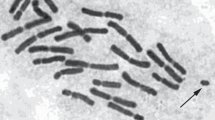Abstract
The karyotypes ofP. juncea (Elymus junceus) andP. huashanica (both outbreeders) were investigated by Feulgen-staining and by C-, N-, and Agbanding, based on a single plant in cach case. Both species have 2n=2x=14 and large chromosomes, possibly a generic character. The karyotype ofP. juncea has 8 metacentrics and 6 SAT-chromosomes with minute, heterochromatic satellites while that ofP. huashanica has 9 metacentrics and 5 SAT-chromosomes only, 2 of which with small, heterochromatic satellites. The C-banding patterns ofP. juncea chromosomes comprise from one to five, mostly small, bands at distal, and terminal positions, while those ofP. huashanica chromosomes are characterized by large telomeric bands in most arms. Banding patterns and chromosome morphology allow identification of the homologues of the seven chromosome pairs inP. juncea, but of two pairs inP. huashanica only. The patterns of both taxa are polymorphic, supporting that both taxa are outbreeders. The karyotypic characters suggest thatP. juncea is more closely related toP. fragilis than either is toP. huashanica. N-banding stains weakly. Silver nitrate staining demonstrates that nucleolus organizers of both species have different nucleolus forming capacities. The presence of micronucleoli suggests that both species have an extra unidentified chromosome with nucleolus forming capacity.
Similar content being viewed by others
References
Anastassova-Kristeva, M., Nicoloff, H., Georgiev, S., 1978: Revision of SAT-chromosome number inTriticum monococcum with respect to nucleolar organizers activity. — Theor. Appl. Genet.53, 229–231.
Bothmer, R. von, Jacobsen, N., Jørgensen, R. B., Linde-Laursen, I., 1984: Haploid barley from the intergeneric crossHordeum vulgare × Psathyrostachys fragilis. — Euphytica33, 363–367.
Dewey, D. R., 1984: The genomic system of classification as a guide to intergeneric hybridization with the perennialTriticeae. — InGustafson, J. P., (Ed.): Gene Manipulation in Plant Improvement, 209–279. — New York: Plenum.
——, 1983: A cytogenetic basis for transferring Russian wildrye fromElymus toPsathyrostachys. — Crop Sci.23, 123–126.
Endo, T. R., Gill, B. S., 1984: The heterochromatin distribution and genome evolution in diploid species ofElymus andAgropyron. — Can. J. Genet. Cytol.26, 669–678.
Greilhuber, J., 1984: Chromosomal Evidence in Taxonomy. — InHeywood, V. H., Moore, D. M., (Eds.): Current Concepts in Plant Taxonomy. Systematics Association Special Vol. 25, 157–180. — London and Orlando: Academic Press.
Heneen, W. K., 1963: Cytology of the intergeneric hybridElymus arenarius × Secale cereale. — Hereditas49, 61–77.
Hunziker, J. H., Naranjo, C. A., Zeiger, E., 1973: Las relaciones evolutivas entreHordeum compressum y otras especies diploides americanas afines. — Kurtziana7, 7–26.
Linde-Laursen, I., 1984: Nucleolus organizer polymorphism in barley,Hordeum vulgare L. — Hereditas100, 33–43.
——, 1984a: Identification of the somatic chromosomes ofPsathyrostachys fragilis (Poaceae). — Can. J. Genet. Cytol.26, 430–435.
—— —— 1984b: Somatic cell cytology of the chromosome eliminating, intergeneric hybridHordeum vulgare × Psathyrostachys fragilis. — Can. J. Genet. Cytol.26, 436–444.
—— —— 1984c: Giemsa C-banded karyotypes of two subspecies ofHordeum brevisubulatum from China. — Pl. Syst. Evol.145, 259–267.
—— ——, 1980: Giemsa C-banding in Asiatic taxa ofHordeum sect.Stenostachys with notes on chromosome morphology. — Hereditas93, 235–254.
Runemark, H., Heneen, W. K., 1968:Elymus andAgropyron, a problem of generic delimitation. — Bot. Not.121, 51–79.
Sakamoto, S., 1973: Patterns of phylogenetic differentiation in the tribeTriticeae. — Seiken Zihô24, 11–31.
Singh, R. J., Röbbelen, G., 1975: Comparison of somatic Giemsa banding pattern in several species of rye. — Z. Pflanzenzüchtg.74, 270–285.
Wang, R. R.-C., Hsiao, C., 1984: Morphology and cytology of interspecific hybrids ofLeymus mollis. — J. Heredity75, 488–492.
Weimarck, A., 1975: Heterochromatin polymorphism in the rye karyotype as detected by the Giemsa C-banding technique. — Hereditas79, 293–300.
Author information
Authors and Affiliations
Rights and permissions
About this article
Cite this article
Linde-Laursen, I., von Bothmer, R. Comparison of the karyotypes ofPsathyrostachys juncea andP. huashanica (Poaceae) studied by banding techniques. Pl Syst Evol 151, 203–213 (1986). https://doi.org/10.1007/BF02430275
Received:
Issue Date:
DOI: https://doi.org/10.1007/BF02430275




